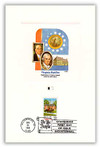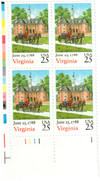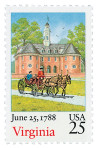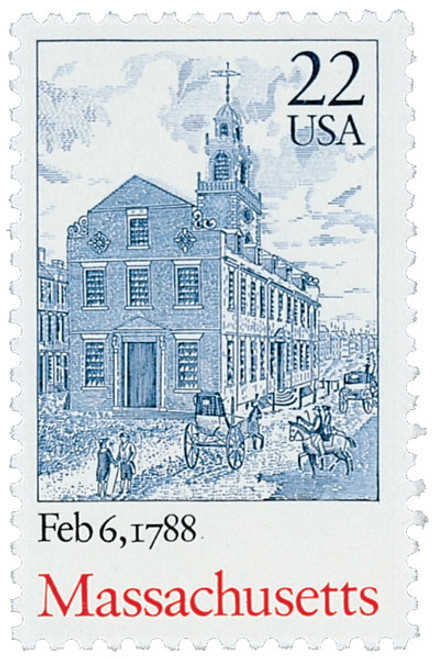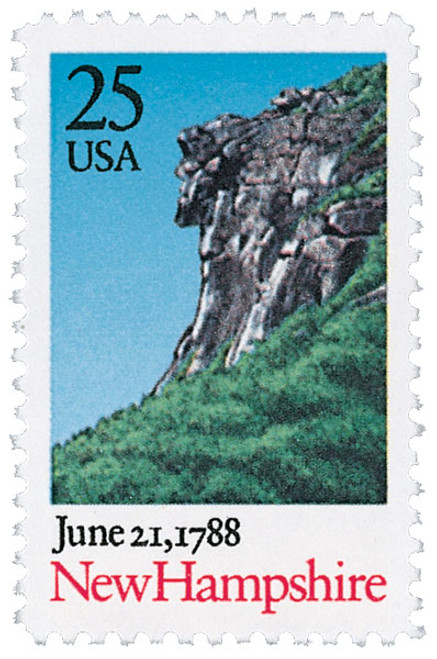
# 2345 - 1988 25c Bicentenary Statehood: Virginia
U.S. #2345
1988 25¢ Virginia
Bicentenary Statehood
- 10th stamp in Bicentenary Statehood Series
- Pictures same capitol building in which the first day ceremony was held
- Issued on 200th statehood anniversary
Stamp Category: Commemorative
Series: Bicentenary Statehood
Value: 25¢, first-class rate
First Day of Issue: June 25, 1988
First Day City: Williamsburg, Virginia
Quantity Issued: 160,245,000
Printed by: Bureau of Engraving and Printing
Printing Method: Lithographed, engraved, & photogravure
Format: Panes of 50 in sheets of 200
Perforations: 11
Why the stamp was issued: As part of a series honoring the 200th statehood anniversaries of the first 13 US states.
About the stamp design: Pierre Mion traveled to Williamsburg to photograph the restored buildings as the basis for his artwork for this stamp. His image of the Governor’s Palace was turned down because it was too “royal,” but the USPS liked the idea of picturing the Capitol building. They considered picturing a close-up of the tower, but didn’t think it was recognizable enough. The final design depicts the building from the street, left of center, with a two-horse carriage passing in front.
First Day City: The First Day ceremony for this stamp was held at the Capitol building depicted on the stamp in Williamsburg, Virginia. Interestingly, Virginia’s capital was located in Richmond in 1788 when they ratified the Constitution.
About the Bicentenary Statehood Series: The 1935 Michigan Centenary stamp is often considered America’s first statehood stamp. However, that stamp actually used the wrong date – Michigan ratified its constitution in 1837, but wasn’t granted statehood until 1837. The first correct statehood stamp marked the 100th anniversary of Arkansas in 1936. In the years since, many other statehood stamps were issued. However, among all these statehood stamps, 13 were missing – the first 13 states that formed our nation. With this series, the USPS planned to honor those state as they deserved.
From 1987-1990, the Bicentenary Statehood Series commemorated the signing of the Constitution by representatives of the first 13 Colonies. The stamps were issued in the 200th year after each state approved the Constitution. They were issued in the order each colony became a state, though not always on the exact date of ratification. Each stamp shows traditional symbols or scenes from the state.
History the stamp represents: On June 25, 1788, Virginia ratified the U.S. Constitution and was admitted as the 10th state of the Union.
Several Indian tribes lived in Virginia when the first European explorers arrived. These included the Powhatan, Monacan and Manahoac, Nahyssan, Occaneechi, Susquehanna, Cherokee, and Nottoway. Spanish Jesuits created a settlement on the York River in 1570, but Indians destroyed it after just a few months.
England’s Queen Elizabeth I granted Sir Walter Raleigh permission to establish a colony in America in 1584. Raleigh sent several expeditions to the New World, but they all failed due to inadequate supplies. At that time, Raleigh and the queen gave the name Virginia to the east coast of America. In 1606, King James I chartered the Virginia Company to create a colony in Virginia. The first permanent English settlement in America was begun at Jamestown in May 1607.
Captain John Smith led Jamestown. Smith guided the colony through many hardships until 1609, when he was injured and had to return to England. Without Smith’s leadership, the colony floundered. The following winter was called the “Starving Time,” and many colonists died of starvation. In the spring, the 60 survivors (out of 214) abandoned the settlement, but shortly after setting sail were met by supply ships led by Governor Thomas West, who was also known as Lord De La Warr. The settlers returned to Jamestown.
In 1612, colonist John Rolfe began raising tobacco. Rolfe also developed a new method for curing the tobacco leaves, and proved that tobacco could be exported to Europe. This product allowed the colony to survive economically. Rolfe married Pocahontas, the daughter of the chief of the Indian confederation around Jamestown, in 1614. This marriage brought peace between the Indians and the colonists.
Two major events occurred in Virginia in 1619. The first representative legislature in America, the House of Burgesses, was formed. The House of Burgesses met with the governor and his council to make laws for the colony. Dutch traders brought the first African slaves in America to Virginia that year as well.
In 1624, Virginia was made a royal colony. The colony expanded westward a great deal. Over time, the colonists in eastern Virginia came to have different interests from those in the West.
Like most other colonists, Virginia’s citizens were disturbed by Britain’s policy of taxation without representation, yet most remained loyal to the king. Virginia’s leaders, Patrick Henry and Thomas Jefferson, led the colony in its dissent. When the House of Burgesses was dissolved, its members met without permission, calling themselves the First Virginia Convention. The members elected the delegates to America’s First Continental Congress. A delegate from Virginia, Peyton Randolph, became its first president. At the Second Virginia Convention, held on March 23, 1775, Patrick Henry made his famous speech, which included the words, “Give me liberty or give me death!”
In June of 1776, Virginia adopted its first Constitution and became an independent commonwealth. This constitution included a declaration of rights written by George Mason – the first bill of rights in an American constitution. In 1776, the colony submitted to the Continental Congress a resolution calling for independence. This resolution became the Declaration of Independence, written by Thomas Jefferson. Many Virginians fought for independence; in fact, more fought than in any other Southern colony. Noted leaders included the great cavalry leader “Light-Horse Harry” Lee, Daniel Morgan, and George Rogers Clark. The last major battle of the Revolutionary War was won on Virginia’s soil. In 1781, Lord Cornwallis surrendered to General Washington at Yorktown, Virginia.
The Articles of Confederation loosely tied the 13 original colonies together. However, the Articles of Confederation soon proved to be inadequate. James Madison and other Virginians led the movement to create the Constitution of the United States. Virginia ratified the Constitution on June 25, 1788, making it the 10th state to enter the Union.
Virginia has been called the Mother of Presidents. Four of the first five U.S. Presidents were from Virginia – George Washington, Thomas Jefferson, James Madison, and James Monroe. (In total, eight U.S. Presidents have hailed from Virginia. The other four were William Henry Harrison, John Tyler, Zachary Taylor, and Woodrow Wilson.)
During the winter of 1860-61, seven Southern states withdrew from the Union. Virginia remained, hoping to find a peaceful resolution to the conflict. But, two days after Abraham Lincoln called for Virginia to supply troops to the Union on April 15, 1861, Virginia voted to secede. Richmond served as the capital of the Confederacy from May 1861 until it was captured in April 1865.
Many people from the western part of the state did not agree with the decision to secede. They set up an independent government in the northwestern portion of the state. On June 20, 1863, 48 Virginia counties became the state of West Virginia, the 35th state to join the Union. In November 1863, two more counties joined West Virginia.
Like much of the Confederacy, Virginia was devastated by the Civil War. More battles were fought there than in any other state. Virginia’s General Robert E. Lee surrendered to General Ulysses S. Grant at Appomattox Court House, Virginia, on April 9, 1865.
During the 1880s, while still recovering from the Civil War, Virginia began building modern industries. These included cigarette factories, cotton textile plants, and shipbuilding plants. Later, in the 1930s, many synthetic textile factories were built. World War II brought many changes to Virginia. Large numbers of people serving in the armed forces moved to Norfolk and Washington, D.C. Many of these people took permanent residence in the state after the war. During the 1960s, the manufacture of chemicals, clothing, electrical equipment, furniture, and transportation equipment increased the state’s economic strength.
Industry’s reliance on coal as a fuel source, as well as increased settlement along the Chesapeake Bay, caused a great deal of pollution in the state of Virginia. Despite this problem, Virginia has a strong economy, mainly due to its broad economic base. Manufacturing, tourism, agriculture, and the activities of the federal government keep the economy healthy.
U.S. #2345
1988 25¢ Virginia
Bicentenary Statehood
- 10th stamp in Bicentenary Statehood Series
- Pictures same capitol building in which the first day ceremony was held
- Issued on 200th statehood anniversary
Stamp Category: Commemorative
Series: Bicentenary Statehood
Value: 25¢, first-class rate
First Day of Issue: June 25, 1988
First Day City: Williamsburg, Virginia
Quantity Issued: 160,245,000
Printed by: Bureau of Engraving and Printing
Printing Method: Lithographed, engraved, & photogravure
Format: Panes of 50 in sheets of 200
Perforations: 11
Why the stamp was issued: As part of a series honoring the 200th statehood anniversaries of the first 13 US states.
About the stamp design: Pierre Mion traveled to Williamsburg to photograph the restored buildings as the basis for his artwork for this stamp. His image of the Governor’s Palace was turned down because it was too “royal,” but the USPS liked the idea of picturing the Capitol building. They considered picturing a close-up of the tower, but didn’t think it was recognizable enough. The final design depicts the building from the street, left of center, with a two-horse carriage passing in front.
First Day City: The First Day ceremony for this stamp was held at the Capitol building depicted on the stamp in Williamsburg, Virginia. Interestingly, Virginia’s capital was located in Richmond in 1788 when they ratified the Constitution.
About the Bicentenary Statehood Series: The 1935 Michigan Centenary stamp is often considered America’s first statehood stamp. However, that stamp actually used the wrong date – Michigan ratified its constitution in 1837, but wasn’t granted statehood until 1837. The first correct statehood stamp marked the 100th anniversary of Arkansas in 1936. In the years since, many other statehood stamps were issued. However, among all these statehood stamps, 13 were missing – the first 13 states that formed our nation. With this series, the USPS planned to honor those state as they deserved.
From 1987-1990, the Bicentenary Statehood Series commemorated the signing of the Constitution by representatives of the first 13 Colonies. The stamps were issued in the 200th year after each state approved the Constitution. They were issued in the order each colony became a state, though not always on the exact date of ratification. Each stamp shows traditional symbols or scenes from the state.
History the stamp represents: On June 25, 1788, Virginia ratified the U.S. Constitution and was admitted as the 10th state of the Union.
Several Indian tribes lived in Virginia when the first European explorers arrived. These included the Powhatan, Monacan and Manahoac, Nahyssan, Occaneechi, Susquehanna, Cherokee, and Nottoway. Spanish Jesuits created a settlement on the York River in 1570, but Indians destroyed it after just a few months.
England’s Queen Elizabeth I granted Sir Walter Raleigh permission to establish a colony in America in 1584. Raleigh sent several expeditions to the New World, but they all failed due to inadequate supplies. At that time, Raleigh and the queen gave the name Virginia to the east coast of America. In 1606, King James I chartered the Virginia Company to create a colony in Virginia. The first permanent English settlement in America was begun at Jamestown in May 1607.
Captain John Smith led Jamestown. Smith guided the colony through many hardships until 1609, when he was injured and had to return to England. Without Smith’s leadership, the colony floundered. The following winter was called the “Starving Time,” and many colonists died of starvation. In the spring, the 60 survivors (out of 214) abandoned the settlement, but shortly after setting sail were met by supply ships led by Governor Thomas West, who was also known as Lord De La Warr. The settlers returned to Jamestown.
In 1612, colonist John Rolfe began raising tobacco. Rolfe also developed a new method for curing the tobacco leaves, and proved that tobacco could be exported to Europe. This product allowed the colony to survive economically. Rolfe married Pocahontas, the daughter of the chief of the Indian confederation around Jamestown, in 1614. This marriage brought peace between the Indians and the colonists.
Two major events occurred in Virginia in 1619. The first representative legislature in America, the House of Burgesses, was formed. The House of Burgesses met with the governor and his council to make laws for the colony. Dutch traders brought the first African slaves in America to Virginia that year as well.
In 1624, Virginia was made a royal colony. The colony expanded westward a great deal. Over time, the colonists in eastern Virginia came to have different interests from those in the West.
Like most other colonists, Virginia’s citizens were disturbed by Britain’s policy of taxation without representation, yet most remained loyal to the king. Virginia’s leaders, Patrick Henry and Thomas Jefferson, led the colony in its dissent. When the House of Burgesses was dissolved, its members met without permission, calling themselves the First Virginia Convention. The members elected the delegates to America’s First Continental Congress. A delegate from Virginia, Peyton Randolph, became its first president. At the Second Virginia Convention, held on March 23, 1775, Patrick Henry made his famous speech, which included the words, “Give me liberty or give me death!”
In June of 1776, Virginia adopted its first Constitution and became an independent commonwealth. This constitution included a declaration of rights written by George Mason – the first bill of rights in an American constitution. In 1776, the colony submitted to the Continental Congress a resolution calling for independence. This resolution became the Declaration of Independence, written by Thomas Jefferson. Many Virginians fought for independence; in fact, more fought than in any other Southern colony. Noted leaders included the great cavalry leader “Light-Horse Harry” Lee, Daniel Morgan, and George Rogers Clark. The last major battle of the Revolutionary War was won on Virginia’s soil. In 1781, Lord Cornwallis surrendered to General Washington at Yorktown, Virginia.
The Articles of Confederation loosely tied the 13 original colonies together. However, the Articles of Confederation soon proved to be inadequate. James Madison and other Virginians led the movement to create the Constitution of the United States. Virginia ratified the Constitution on June 25, 1788, making it the 10th state to enter the Union.
Virginia has been called the Mother of Presidents. Four of the first five U.S. Presidents were from Virginia – George Washington, Thomas Jefferson, James Madison, and James Monroe. (In total, eight U.S. Presidents have hailed from Virginia. The other four were William Henry Harrison, John Tyler, Zachary Taylor, and Woodrow Wilson.)
During the winter of 1860-61, seven Southern states withdrew from the Union. Virginia remained, hoping to find a peaceful resolution to the conflict. But, two days after Abraham Lincoln called for Virginia to supply troops to the Union on April 15, 1861, Virginia voted to secede. Richmond served as the capital of the Confederacy from May 1861 until it was captured in April 1865.
Many people from the western part of the state did not agree with the decision to secede. They set up an independent government in the northwestern portion of the state. On June 20, 1863, 48 Virginia counties became the state of West Virginia, the 35th state to join the Union. In November 1863, two more counties joined West Virginia.
Like much of the Confederacy, Virginia was devastated by the Civil War. More battles were fought there than in any other state. Virginia’s General Robert E. Lee surrendered to General Ulysses S. Grant at Appomattox Court House, Virginia, on April 9, 1865.
During the 1880s, while still recovering from the Civil War, Virginia began building modern industries. These included cigarette factories, cotton textile plants, and shipbuilding plants. Later, in the 1930s, many synthetic textile factories were built. World War II brought many changes to Virginia. Large numbers of people serving in the armed forces moved to Norfolk and Washington, D.C. Many of these people took permanent residence in the state after the war. During the 1960s, the manufacture of chemicals, clothing, electrical equipment, furniture, and transportation equipment increased the state’s economic strength.
Industry’s reliance on coal as a fuel source, as well as increased settlement along the Chesapeake Bay, caused a great deal of pollution in the state of Virginia. Despite this problem, Virginia has a strong economy, mainly due to its broad economic base. Manufacturing, tourism, agriculture, and the activities of the federal government keep the economy healthy.






